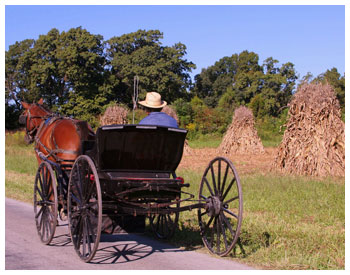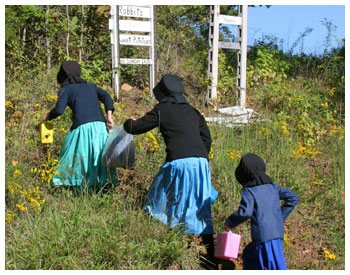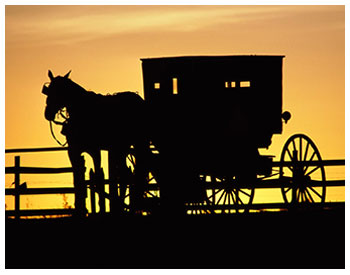Hard Work, Plain Living.

Visiting the Amish in Crittenden County is like taking a step back in time. They have no telephones or electricity and use horses and buggies for transportation. When you visit, you will see their meticulous care of the land, their craftsmanship in cabinet and furniture making, along with their artistry in handmade quilts and other crafts.
The Amish and Mennonites were part of the early Anabaptist movement in Europe, which took place at the time of the Reformation. The Anabaptists (late baptizers) believed that only adults who had confessed their faith should be baptized, and that they should remain separate from the larger society. Both Catholics and Protestants put many early Anabaptists to death as heretics, and many others fled to the mountains of Switzerland and southern Germany. Here began the Amish tradition of self-sufficient farming and home-based worship services.
In 1536, a young Catholic priest from Holland named Menno Simons joined the Anabaptist movement. His writings and leadership united many of the Anabaptist groups, who were nicknamed "Mennonites."
In 1693, a Swiss bishop named Jacob Amman broke from the Mennonite church. His followers were called the "Amish." Although the two groups have split several times, the Amish and Mennonite churches still share the same beliefs concerning baptism, non-resistance, and basic Bible doctrines. They differ in matters of dress, technology, language, form of worship, and interpretation of the Bible.
The Amish and Mennonites both settled in Pennsylvania as part of William Penn's "holy experiment" of religious tolerance. The first sizable group of Amish arrived in Lancaster County in the 1720s. In 1824, they declared themselves separate from the home church in Europe.
The first Amish settlement in Crittenden County was established in 1977. At present the Amish population has grown to almost 400 residents
 The Amish people in Crittenden County have four local church districts. A church district is a group of about 30 families usually living close together. Church services are usually held every second Sunday in members' homes. They take turns hosting the services. The host family prepares lunch and supper for the entire group on Saturday, since sabbath rules forbid cooking on Sunday.
The Amish people in Crittenden County have four local church districts. A church district is a group of about 30 families usually living close together. Church services are usually held every second Sunday in members' homes. They take turns hosting the services. The host family prepares lunch and supper for the entire group on Saturday, since sabbath rules forbid cooking on Sunday.
Services are in German, and may last three hours. No musical instruments are used. The first floor rooms are usually separated by a divider that can be opened when the family is hosting church for their district, or is having a family wedding or funeral.
The local community has four bishops and several ministers. Church members select candidates to be ministers, deacons, and bishops. These candidates select a book from a pile. If the book has a sheet of paper in it, that person is "chosen" and then ordained.
The Amish follow the Ordnung, or "order" of discipline based on the Bible. Violation of the Ordnung can lead to meidung, shunning or excommunication, and introduced in 1897.(This is based on Matthew 18:15-17; Romans 16:17; and 1 Corinthians 5:11.) Other Amish, including spouse, children, or parents, will no longer speak to an excommunicated member. As extreme as this sounds, the shun is lifted as soon as the member makes a confession of their wrongdoing.
The community has six schools and uses Amish teachers. Presently, they have five female and one male teacher. Students attend school through the 8th grade. German is spoken in their homes. Most children do not begin to learn English until they start to school. People who speak English at home are called "the English," but the term is also applied to any non-Amish or non-Mennonite.
Amish men and boys wear dark suits, coats without lapels, suspenders, black pants, white or plain colored pastel shirts, black shoes, and black or straw-brimmed hats. Their hair is worn full and cut at the collar line. Amish men shave until baptism, then let their beards grow (marriage usually follows shortly after baptism). Mustaches are forbidden because of their historical association with the military. As pacifists, the Amish do not believe in taking part in war.
Amish women and girls do not cut their hair, but wear it parted in the middle and rolled severely back from the face. It is then twisted into a bun at the nape of the neck. A white organdy prayer veil called a "kapp" covers the back and top of the head. When going out the women put on a large black bonnet and shawl. No one wears jewelry.
 An Amish woman is a worker, a child bearer, and a companion to her husband, family, and neighbors. She and her husband eat three meals a day together. She has a family to tend, but they share her responsibilities. Most farms are co-owned by both husband and wife. The woman may make household purchases, bid at auctions, and write checks to pay bills. In church, although not given any leadership responsibilities, she may vote and make nominations.
An Amish woman is a worker, a child bearer, and a companion to her husband, family, and neighbors. She and her husband eat three meals a day together. She has a family to tend, but they share her responsibilities. Most farms are co-owned by both husband and wife. The woman may make household purchases, bid at auctions, and write checks to pay bills. In church, although not given any leadership responsibilities, she may vote and make nominations.
The Amish don't use middle names, but with the increase in government paperwork, they now use middle initials. Usually the the first initial of the father's name is given as a middle initial for their children's names. This is done out of respect for the father. The Mennonites, on the other hand, use the first letter of the mother's maiden name.
Rumspringen" a time of "running around," encourages Amish youth to see a little of the 'English' world before making an informed decision to join the church. During this time, a young man may decorate his carriage and harness with chrome or white ornaments, drawing attention from the young ladies.
Youth enter adulthood when they make a formal confession of their faith, receive baptism, and make a lifetime vow of obedience to the Ordnung. At this time, young men stop shaving their beards to show they have accepted baptism Baptism is often postponed until just before marriage, since it's required for marriage. An Amish wedding service lasts approximately 3 1/2 hours. After the ceremony, a huge feast is served for as many as 400 people.
Many Amish believe that, if the church is faithful to its calling, government programs and commercial insurance are not needed. That conviction forced them to testify before Congress because they did not want to receive Social Security benefits. They wanted the right to look after their own elderly. They were given approval, if self-employed, to be exempt from paying the tax. They do not object to paying income tax, real estate, county, and sales tax.
The Amish grow most of their food. The women can vegetables, meat, and relishes. Most make their own bread and noodles. Staples are purchased from local grocery stores.
Though known today for buggies, the Amish originally didn't even use these. The first documented use of wheeled vehicles among the plain people was in the Lancaster, PA area when Mr. Christian Zimmerman was allowed the privilege of wheeled travel around 1800 because he could not ride horseback with his excessive weight. It was considered too cruel to the horse!
Questions? E-mail us, we'll be glad to answer! michele@marionkentucky.org